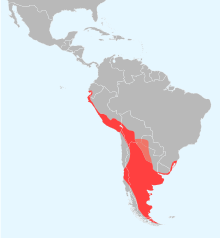Chilean flamingo
| Chilean flamingo | |
|---|---|
 |
|
| Chilean flamingo with egg at the Tiergarten in Bernburg, Germany | |
| Scientific classification | |
| Kingdom: | Animalia |
| Phylum: | Chordata |
| Class: | Aves |
| Order: | Phoenicopteriformes |
| Family: | Phoenicopteridae |
| Genus: | Phoenicopterus |
| Species: | P. chilensis |
| Binomial name | |
|
Phoenicopterus chilensis Molina, 1782 |
|
 |
|
| Synonyms | |
|
|
The Chilean flamingo (Phoenicopterus chilensis) is a large species of flamingo at 110–130 cm (43–51 in) closely related to American flamingo and greater flamingo, with which it was sometimes considered conspecific. The species is listed as Near Threatened by the IUCN.
It breeds in South America from Ecuador and Peru to Chile and Argentina and east to Brazil; it has been introduced into Germany and the Netherlands (colony on the border, Zwillbrocker Venn). There was also a small population in Utah and California. Like all flamingos it lays a single chalky white egg on a mud mound.
The plumage is pinker than the slightly larger greater flamingo, but less so than Caribbean flamingo. It can be differentiated from these species by its greyish legs with pink joints (tibio-tarsal articulation), and also by the larger amount of black on the bill (more than half). Young chicks may have no sign of pink coloring whatsoever, but instead remain grey.
The Chilean flamingo's bill is equipped with comb-like structures that enable it to filter food—mainly algae and plankton—from the water of the coastal mudflats, estuaries, lagoons and salt lakes where it lives.
Chilean flamingos live in large flocks in the wild and require crowded conditions to stimulate breeding. During breeding season, males and females display a variety of behaviors to attract mates, including head flagging—swiveling their heads from side-to-side in tandem—and wing salutes, where the wings are repeatedly opened and closed. Males and females cooperate in building a pillar-shaped mud nest, and both incubate the egg laid by the female. Upon birth, the chicks have gray plumage; they don't gain the typical pink adult coloration for two-three years. Both male and female flamingos can produce a nutritious milk-like substance in their crop gland to feed their young.
...
Wikipedia

